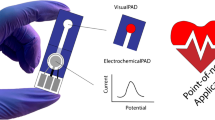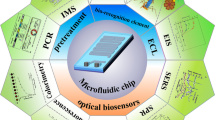Abstract
Canine species detection in foods is important in the perspectives of health, religions, and fare-trade food business. This study describes a very short-amplicon length Polymerase Chain Reaction (PCR)-Restriction Fragment Length Polymorphism (RFLP) assay with lab-on-a-chip detection platform for the authentication of canine DNA in processed foods. A 100-bp fragment of canine mitochondrial Cytochrome b (cytb) gene was selected and amplified using a pair of canine-specific primers. The amplified PCR products were validated by RFLP analysis using lab-on-a-chip microfluidic bioanalyzer kit. Both gel-image and electropherograms authenticated the canine-specific PCR products before (100 bp) and after restriction digestion (51, 30, and 19 bp). The assay successfully detected 0.0001-ng canine DNA under pure state and 0.01 % (w/w) canine meat spiked in chicken and beef burger formulations. Screening of eight commercial burgers across Malaysia did not reveal any canine adulteration. We believe the assay would find potential applications in food industries, Halal food regulatory bodies and animal right protection authorities across the globe.




Similar content being viewed by others
References
Abdel-Rahman S, El-Saadani M, Ashry K, Haggag A (2009) Detection of adulteration and identification of cat’s, dog’s, donkey’s and horse’s meat using species-specific PCR and PCR-RFLP techniques. Aust J Basic Appl Sci 3:1716
Abdulmawjood A, Schönenbrücher H, Bülte M (2003) Development of a polymerase chain reaction system for the detection of dog and cat meat in meat mixtures and animal feed. J Food Sci 68:1757
Addinsoft S (2013) XLSTAT-PLSPM. Paris, France
Aida AA, Che Man YB, Wong CMVL, Raha AR, Son R (2005) Analysis of raw meats and fats of pigs using polymerase chain reaction for Halal authentication. Meat Sci 69:47–52
Ali ME, Hashim U, Dhahi TS, Mustafa S, Man Y, Latif MA (2012a) Analysis of pork adulteration in commercial burgers targeting porcine-specific mitochondrial cytochrome B gene by TaqMan probe real-time polymerase chain reaction. Food Anal Methods 5:784–794
Ali ME, Hashim U, Mustafa S, Che Man YB (2012b) Swine-specific PCR-RFLP assay targeting mitochondrial cytochrome B gene for semiquantitative detection of pork in commercial meat products. Food Anal Methods 5:613–623
Ali ME, Kashif M, Uddin K, Hashim U, Mustafa S, Che Man YB (2012c) Species authentication methods in foods and feeds: the present, past, and future of Halal Forensics. Food Anal Methods 5:935–955
Ali ME, Rahman MM, Hamid SBA, Mustafa S, Bhassu S, Hashim U (2013) Canine-specific PCR assay targeting cytochrome b gene for the detection of dog meat adulteration in commercial Frankfurters. Food Anal Methods 1–8
Ali ME, Razzak MA, Hamid SBA (2014) Multiplex PCR in species authentication: probability and prospects—a review. Food Anal Methods 1–17
Arslan A, Ilhak OI, Calicioglu M (2006) Effect of method of cooking on identification of heat processed beef using polymerase chain reaction (PCR) technique. Meat Sci 72:326–330
Bird S (2012) A truly monstrous medicine: the mail investigates China’s gruesome human baby flesh pills. Mail online. Retrieved from http://www.dailymail.co.uk/news/article-2143294/A-truly-monstrous-medicine-The-Mail-investigates-Chinas-gruesome-human-baby-flesh-pills.html
Bonne K, Verbeke W (2008) Religious values informing Halal meat production and the control and delivery of halal credence quality. Agric Hum Values 25:35–47
Bottero M, Civera T, Anastasio A, Turi R, Rosati S (2002) Identification of cows milk in “buffalo” cheese by duplex polymerase chain reaction. J Food Prot 65:362–366
Bustin SA, Benes V, Garson JA, Hellemans J, Huggett J, Kubista M, Mueller R, Nolan T, Pfaffl MW, Shipley GL (2009) The MIQE guidelines: minimum information for publication of quantitative real-time PCR experiments. Clin Chem 55:611–622
Chakravorty S (2014) Pork DNA found in two chocolate products of Cadbury Malaysia: Report. Reuters. Retrived from: http://www.reuters.com/article/2014/05/26/us-mondelez-intl-recall-idUSBREA4P0CH20140526
Commission E (2002) Commission Decision 2002/657/EC of 12 August 2002 implementing Council Directive 96/23/EC concerning the performance of analytical methods and the interpretation of results. Off J Eur Communities L 221:8–36
Di Pinto A, Forte VT, Conversano MC, Tantillo GM (2005) Duplex polymerase chain reaction for detection of pork meat in horse meat fresh sausages from Italian retail sources. Food Control 16:391–394
Doosti A, Ghasemi Dehkordi P, Rahimi E (2011) Molecular assay to fraud identification of meat products. J Food Sci Technol 1–5
Funes-Huacca M, de Almeida C, Regitano L, Mueller O, Carrilho E (2004) Semiquantitative determination of Alicyclobacillus acidoterrestris in orange juice by reverse-transcriptase polymerase chain reaction and capillary electrophoresis—laser induced fluorescence using microchip technology. Electrophoresis 25:3860–3864
Gao H-W, Xu B-L, Liang C-Z, Zhang Y-B, Zhu L-H (2004) Polymerase chain reaction method to detect canis materials by amplification of species-specific DNA fragment. J OAC Int 87:1195–1199
Hall T (2004) BioEdit version 7.0. 0. Distributed by the author, website: www.mbio.ncsu.edu/BioEdit/bioedit.html
İlhak Oİ, Arslan A (2007) Identification of meat species by polymerase chain reaction (PCR) technique. Turk J Vet Anim Sci 31:159–163
Ismail ZI (2014) Islamic capital mart a viable alternative. New Straits Time. Retrived from http://www.nst.com.my/node/29680
Khattak JZK, Mir A, Anwar Z, Abbas G, Khattak HZK, Ismatullah H (2011) Concept of Halal food and biotechnology. Adv J Food Sci Tech 3
Kumarapeli V, Awerbuch-Friedlander T (2009) Human rabies focusing on dog ecology—a challenge to public health in Sri Lanka. Acta Trop 112:33–37
Mane BG, Mendiratta SK, Tiwari AK (2009) Polymerase chain reaction assay for identification of chicken in meat and meat products. Food Chem 116:806–810
Martín I, García T, Fajardo V, Rojas M, Hernández P, González I, Martín R (2007) Technical note: detection of cat, dog, and rat or mouse tissues in food and animal feed using species-specific polymerase chain reaction. J Anim Sci 85:2734–2739
Nam K-C, Jo C, Lee M (2010) Meat products and consumption culture in the East. Meat Sci 86:95–102
Olumide (2014) Human meat discovered in McDonald’s meat factory. Informationnigeriaorg Retrived from http://www.informationng.com/2014/08/human-meat-discovered-in-mcdonalds-meat-factory.html
Pereira F, Carneiro J, Amorim A (2008) Identification of species with DNA-based technology: current progress and challenges. Recent Patents DNA Gene Seq 2:187–200
Podberscek AL (2009) Good to pet and eat: the keeping and consuming of dogs and cats in South Korea. J Soc Issues 65:615
Rahman MM, Ali ME, Hamid SBA, Mustafa S, Hashim U, Hanapi UK (2014) Polymerase chain reaction assay targeting cytochrome b gene for the detection of dog meat adulteration in meatball formulation. Meat Sci 97:404–409
Rodríguez MA, García T, González I, Hernández PE, Martín R (2005) TaqMan real-time PCR for the detection and quantitation of pork in meat mixtures. Meat Sci 70:113–120
Rohman A, Sismindari, Erwanto Y, Che Man YB (2011) Analysis of pork adulteration in beef meatball using Fourier transform infrared (FTIR) spectroscopy. Meat Sci 88:91–95
Rojas M, González I, Pavón MÁ, Pegels N, Lago A, Hernández PE, García T, Martín R (2010) Novel TaqMan real-time polymerase chain reaction assay for verifying the authenticity of meat and commercial meat products from game birds. Food Addit Contam 27:749
Sait M, Clark EM, Wheelhouse N, Spalding L, Livingstone M, Sachse K, Markey BK, Magnino S, Siarkou VI, Vretou E, Caro MR, Yaga R, Lainson FA, Smith DGE, Wright F, Longbottom D (2011) Genetic variability of Chlamydophila abortus strains assessed by PCR-RFLP analysis of polymorphic membrane protein-encoding genes. Vet Microbiol 151:284–290
Salieb-Beugelaar G, Dorfman K, Van den Berg A, Eijkel J (2009) Electrophoretic separation of DNA in gels and nanostructures. Lab Chip 9:2508–2523
Tamura K, Nei M, Kumar S (2004) Prospects for inferring very large phylogenies by using the neighbor-joining method. Proc Natl Acad Sci U S A 101:11030–11035
Tamura K, Peterson D, Peterson N, Stecher G, Nei M, Kumar S (2011) MEGA5: molecular evolutionary genetics analysis using maximum likelihood, evolutionary distance, and maximum parsimony methods. Mol Biol Evol 28:2731–2739
Thompson JD, Higgins DG, Gibson TJ (1994) CLUSTAL W: improving the sensitivity of progressive multiple sequence alignment through sequence weighting, position-specific gap penalties and weight matrix choice. Nucleic Acids Res 22:4673
Totton SC, Wandeler AI, Zinsstag J, Bauch CT, Ribble CS, Rosatte RC, McEwen SA (2010) Stray dog population demographics in Jodhpur, India following a population control/rabies vaccination program. Prev Vet Med 97:51–57
Wong EH-K, Hanner RH (2008) DNA barcoding detects market substitution in North American seafood. Food Res Int 41:828–837
Wu JH, Hong PY, Liu WT (2009) Quantitative effects of position and type of single mismatch on single base primer extension. J Microbiol Meth 77:267–275
Yang I, Kim Y-H, Byun J-Y, Park S-R (2005) Use of multiplex polymerase chain reactions to indicate the accuracy of the annealing temperature of thermal cycling. Anal Biochem 338:192–200
Yusop M, Mustafa S, Che Man Y, Omar A, Mokhtar N (2012) Detection of raw pork targeting porcine-specific mitochondrial cytochrome B gene by molecular beacon probe real-time polymerase chain reaction. Food Anal Methods 5:422–429
Acknowledgments
This research was jointly supported by University of Malaya research grant no. GC001A-14SBS to M.E. Ali and grant no: RU002-2014 to S.B.A. Hamid. M.M. Rahman is a recipient of Malaysian International Scholarship no. KPT.B.600-18/3 Vol2 133.
Conflict of Interest
Md. Eaqub Ali declares that he received funding support from the University of Malaya, supervised this work, and edited manuscript, and he has no conflict of interest to publish this paper. Md. Mahfujur Rahman declares that he performed this work under the supervision of Md. Eaqub Ali, and he has no conflict of interest to publish this paper. Sharifah Bee Abd Hamid declares that she paid salary to Md. Mahfujur Rahman from her research grant, and she has no conflict of interest to publish this paper. Subha Bhassu declares that she provided some reagents to Md. Mahfujur Rahman, and she has no conflict of interest to publish this paper. Shuhaimi Mustafa declares that he ensured lab facilities for this work, and he has no conflict of interest to publish this paper. Md. Al Amin declares that he helped Md. Mahfujur Rahman in sample collection, and he has no conflict of interest to publish this paper. Md. Abdur Razzak declares that he helped Md. Mahfujur Rahman in experiments, and he has no conflict of interest to publish this paper.
Compliance with Ethics Requirements
Ethical clearance of ref. no: NANOCAT /25/04/3013/ MMR (R) was obtained from the Institutional Animal Care and Use Committee, University of Malaya (UM IACUC), and all experiments were conducted and animal meats were handled following the national and institutional guideline.
Author information
Authors and Affiliations
Corresponding author
Rights and permissions
About this article
Cite this article
Rahman, M.M., Ali, M.E., Hamid, S.B.A. et al. Lab-on-a-Chip PCR-RFLP Assay for the Detection of Canine DNA in Burger Formulations. Food Anal. Methods 8, 1598–1606 (2015). https://doi.org/10.1007/s12161-015-0090-1
Received:
Accepted:
Published:
Issue Date:
DOI: https://doi.org/10.1007/s12161-015-0090-1




